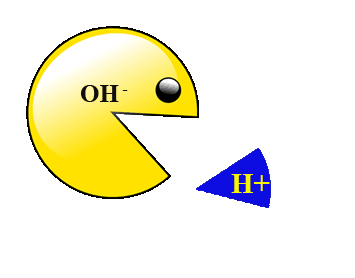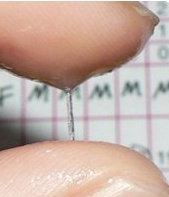Imagine the acidic species, the H+ releasers, as food for pac-men, who are the hydroxide ions(OH-), common H+ acceptors. For a neutralization reaction to go to completion, all of the pac-men have to be fed. The stuffed pacman is a molecule of water.  However, the reality is a little more complex than the analogy. The unfed pacmen and their food are not originally separate or isolated species. They have counterparts which react to produce a salt. If the salt is incapable of generating either a basic or acidic ion in water, then we will have a perfectly neutral solution. Otherwise, the neutralization reaction will leave behind either an acidic or basic(alkaline) solution, albeit one that's closer to pH 7 than the unneutralized one.
However, the reality is a little more complex than the analogy. The unfed pacmen and their food are not originally separate or isolated species. They have counterparts which react to produce a salt. If the salt is incapable of generating either a basic or acidic ion in water, then we will have a perfectly neutral solution. Otherwise, the neutralization reaction will leave behind either an acidic or basic(alkaline) solution, albeit one that's closer to pH 7 than the unneutralized one.
The first neutralization reaction associated with sex occurs within the penis. Urine usually leaves behind an acidic residue in the urethra, a passageway shared by the male's reproductive and excretory systems. There are a few unbuffered organic acids in urine that usually make it slightly acidic. They include benzoic acid, oxalic acid (which comes from oxalates in plant material) and acetic acid, which resurfaces a little later in our story. But the acids are neutralized by the pea-sized Cowper's glands' pre-ejaculatory fluid, which contains an alkaline secretion. This preserves semen's alkaline pH due to spermine, spermidine and the foul-smelling putrescine and cadaverine. The important quartet of amines is secreted by the seminal vesicles next to the prostate gland. Sperm cells are vulnerable to acid because their cells are little more than naked genetic nuclei, and a low pH will denature DNA.
Whereas semen contains 2 to 4 times as much hydroxide as what's found at pH = 7 (water is in equilibrium with very small and equal amounts of H+ and OH-), vaginal fluid's pH normally ranges from 3.8 to 4.5. This protects the warm, dark canal from most bacteria, who prefer a pH range of 6.5 to 7.5. So the vagina should never be washed with soap, which would neutralize protective acids.
Soap is alkaline because its main ingredient is a salt formed from the neutralization of a fatty acid. The positive portion of this salt is sodium ion, which is relatively inert in water. But the negative ion neutralizes H+ from water, causing the latter to churn out more hydroxide ions.
 However, the reality is a little more complex than the analogy. The unfed pacmen and their food are not originally separate or isolated species. They have counterparts which react to produce a salt. If the salt is incapable of generating either a basic or acidic ion in water, then we will have a perfectly neutral solution. Otherwise, the neutralization reaction will leave behind either an acidic or basic(alkaline) solution, albeit one that's closer to pH 7 than the unneutralized one.
However, the reality is a little more complex than the analogy. The unfed pacmen and their food are not originally separate or isolated species. They have counterparts which react to produce a salt. If the salt is incapable of generating either a basic or acidic ion in water, then we will have a perfectly neutral solution. Otherwise, the neutralization reaction will leave behind either an acidic or basic(alkaline) solution, albeit one that's closer to pH 7 than the unneutralized one.The first neutralization reaction associated with sex occurs within the penis. Urine usually leaves behind an acidic residue in the urethra, a passageway shared by the male's reproductive and excretory systems. There are a few unbuffered organic acids in urine that usually make it slightly acidic. They include benzoic acid, oxalic acid (which comes from oxalates in plant material) and acetic acid, which resurfaces a little later in our story. But the acids are neutralized by the pea-sized Cowper's glands' pre-ejaculatory fluid, which contains an alkaline secretion. This preserves semen's alkaline pH due to spermine, spermidine and the foul-smelling putrescine and cadaverine. The important quartet of amines is secreted by the seminal vesicles next to the prostate gland. Sperm cells are vulnerable to acid because their cells are little more than naked genetic nuclei, and a low pH will denature DNA.
Whereas semen contains 2 to 4 times as much hydroxide as what's found at pH = 7 (water is in equilibrium with very small and equal amounts of H+ and OH-), vaginal fluid's pH normally ranges from 3.8 to 4.5. This protects the warm, dark canal from most bacteria, who prefer a pH range of 6.5 to 7.5. So the vagina should never be washed with soap, which would neutralize protective acids.
Soap is alkaline because its main ingredient is a salt formed from the neutralization of a fatty acid. The positive portion of this salt is sodium ion, which is relatively inert in water. But the negative ion neutralizes H+ from water, causing the latter to churn out more hydroxide ions.
When a woman is sexually stimulated, the blood vessels around the vagina become engorged. The ensuing pressure on the surrounding tissues cause the vaginal walls to exude tiny droplets. Their main acidic ingredient is acetic acid, also found in vinegar. The droplets eventually coalesce and their other components serve to lubricate the sexual canal during intercourse. After male ejaculation, the semen's amine bases protect the sperm cells by neutralizing nearby H+ from the acetic acid.
The ensuing pressure on the surrounding tissues cause the vaginal walls to exude tiny droplets. Their main acidic ingredient is acetic acid, also found in vinegar. The droplets eventually coalesce and their other components serve to lubricate the sexual canal during intercourse. After male ejaculation, the semen's amine bases protect the sperm cells by neutralizing nearby H+ from the acetic acid.
There you have it: another instance of how it is impossible to escape chemistry. I must admit, though, that I have not reached the stage where neutralization enters my consciousness while I'm loving my wife. I only think about the H+-OH--sex connection in bed when she's asleep or reading.
According to one double-blind study, involving you-guessed it--50 college students, aside from the always prevalent acetic acid, a minority of women also produce elevated levels of minor organic acids such as butanoic and propanoic acids, especially during the first half of their menstrual cycles. Butanoic acid, also known as butyric acid, is a component of body odor. The production of all acids in the vagina decreased for women who were on oral contraceptives.
One might be tempted to get other college women to participate in a seemingly more fruitful study, pun intended. Maybe, if you coat a tampon with the necessary enzymes and ethyl alcohol, it will react with both acetic and butyric acids from their secretions to produce the fruity, non toxic ethyl acetate and ethyl butyrate, which smel ls like pineapple. Problem? That's right. Eliminating acid will lead to vaginal infections. Well, you can always try it on armpits, assuming you can get the enzymes to work.
ls like pineapple. Problem? That's right. Eliminating acid will lead to vaginal infections. Well, you can always try it on armpits, assuming you can get the enzymes to work.
According to one double-blind study, involving you-guessed it--50 college students, aside from the always prevalent acetic acid, a minority of women also produce elevated levels of minor organic acids such as butanoic and propanoic acids, especially during the first half of their menstrual cycles. Butanoic acid, also known as butyric acid, is a component of body odor. The production of all acids in the vagina decreased for women who were on oral contraceptives.
One might be tempted to get other college women to participate in a seemingly more fruitful study, pun intended. Maybe, if you coat a tampon with the necessary enzymes and ethyl alcohol, it will react with both acetic and butyric acids from their secretions to produce the fruity, non toxic ethyl acetate and ethyl butyrate, which smel